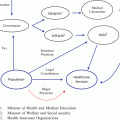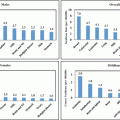Fig. 18.1
Kazakhstan on the world map
Kazakhstan was the last of the Soviet republics to declare independence following the dissolution of the Soviet Union in 1991; the current President, Nursultan Nazarbayev, has been leader of the country since then. Kazakhstan pursues a balanced foreign policy and works to develop its economy, especially its dominant hydrocarbon industry.
Kazakhstan has the second largest uranium, chromium, lead, and zinc reserves, the third largest manganese reserves, the fifth largest copper reserves, and ranks in the top ten for coal, iron, and gold. Perhaps most significant for economic development, Kazakhstan also currently has the 11th largest proven reserves of both petroleum and natural gas.
Kazakhstan is populated by 131 ethnicities, including Kazakh (who make up 63 % of the population), Russian, Uzbek, Ukrainian, German, Tatar, and Uyghur. Islam is the religion of about 70 % of the population, with Christianity practiced by 26 %; Kazakhstan allows freedom of religion. The Kazakh language is the state language, while Russian has equal official status for all levels of administrative and institutional purposes.
Health care in Kazakhstan is provided by a network of primary, secondary, and tertiary care facilities. Health care facilities are largely owned and operated by the public sector represented by the Ministry of Health. Health insurance is now primarily provided by the government in the public sector.
Current Status of Cancer Care
In Kazakhstan, oncology mortality takes second place in the structure of mortality causes (Fig. 18.2). Every year over 17,000 people die from cancer in our country, more than 40 % of them are working-age individuals. Over the past 5 years, there is an upward tendency in the absolute number of cases of malignant tumors; annual increase of such patients is 5 %. In 2009, there were 28.3 thousand of oncology affected; by the end of 2013 this number exceeded 32,000.
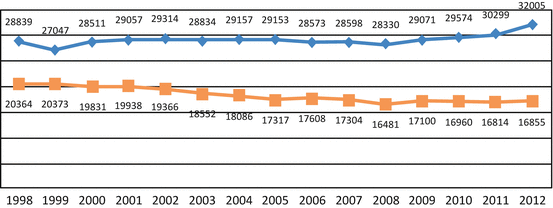

Fig. 18.2
Dynamics of morbidity and mortality in Kazakhstan for 15 years. Source: Kazakh Scientific Institute of Oncology and Radiology (2013). Indicators of Oncology Services in Kazakhstan. Almaty
Mortality rate for the same period decreased by 14.1 % from 113.7 per 100,000 of population in 2006 to 99.6 per 100,000 of population in 2013 (in ppm).
Decrease of mortality rate is primarily due to the improvement of early diagnosis of malignant neoplasms and implementation of a national screening system, as well as the development of integrated treatment methods. At the same time, the rate is still below the rates of developed countries because mortality at later stages of cancer is hardly avoidable and very high.
The most common malignant tumors in 2013 in the country were breast cancer (12.1 %), lung cancer (11.7 %), skin cancer and melanoma (11.5 %), and colorectal cancer (9.2 %).
Key indicators describing current situation in Kazakhstan in terms of cancer are revealed in Tables 18.1, 18.2, 18.3, 18.4, 18.5, and 18.6 (Source: Kazakh Scientific Institute of Oncology and Radiology (2013). Indicators of Oncology Services in Kazakhstan. Almaty).
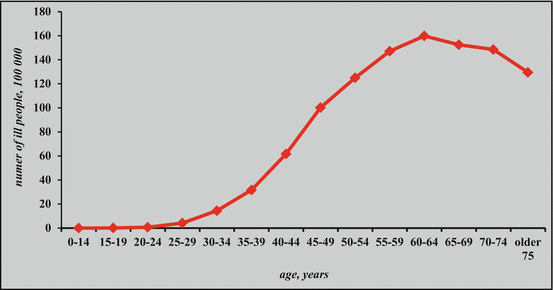
Table 18.1
Cancer incidence rates in 2013
Lung cancer (17.6 %) | 1 |
Stomach cancer (12.6 %) | 2 |
Breast cancer (8.1 %) | 3 |
Esophageal cancer (5.9 %) | 4 |
Colon cancer (4.9 %) | 5 |
Pancreatic cancer (4.9 %) | 6 |
Table 18.2
Mortality rates in 2013
Female | Male |
|---|---|
Breast 23.8 % | Lung 21.4 % |
Skin (+mel.) 11.6 % | Stomach 12.9 % |
Cervical 9.6 % | Skin (+mel.) 9.3 |
Table 18.3
Morbidity by cancer types, women, %
Rank | 2012 | 2013 |
|---|---|---|
1. Breast | 22.3 | 21.5 |
2. Skin | 11.1 | 12.1 |
3. Cervical | 9.2 | 9.1 |
4. Uterus | 5.6 | 6.1 |
5. Stomach | 5.7 | 5.7 |
Table 18.4
Annual morbidity among women (4000 breast cases)

Table 18.5
Morbidity by cancer types, men, %
Rank | 2012 | 2013 |
|---|---|---|
1. Lung | 20.6 | 19.9 |
2. Stomach | 12 | 11.8 |
3. Skin | 9.6 | 10.1 |
4. Colorectal cancer | 4.6 | 4.7 |
Table 18.6
National cancer care development program for 2012–2016
Improvement of life expectancy and quality of life of Kazakhstan citizens by lowering cancer mortality statistics | Objective |
|---|---|
Advancement of cancer prevention through the development of screening programs. Increasing the access to high-technology methods of diagnostics and treatment that with proved efficiency. Creation of a modern system of rehabilitation and palliative care for cancer patients | Aims |
2012–2016 | Term of implementation |
Decrease of cancer mortality to 97. 2 per 100 K by 2014, to 95.5 per 100 K by 2016; increase of percentage of I–II Stage cancers to 51.5 % by 2014, to 53.5 % by 2016; increase of 5-year survival rate among cancer patients to 52.0 % by 2014, to 52.5 % by 2016 | Target indicators |
State and local budgets Overall costs: 178.6 billion Tenge. (*$1.2 bln) | Sources and volumes of financing |
First place in the prevalence of cancer in the female population belongs to tumors of the breast which is more than 20 %. Then, it is followed by tumors of the skin, cervix, uterus, and stomach cancer. Another problem is that malignant neoplasms are affecting more and more young people. The mean age of women diagnosed with breast cancer is 60 (Tables 18.3 and 18.4).
Within the structure of morbidity among men, leading places are shared by lung cancer, stomach cancer, and skin tumors.
Geographically, leading positions in cancer morbidity and mortality for the last several years held by north and west regions of the country. Figure 18.3 demonstrates dissemination of cancer types among country regions.
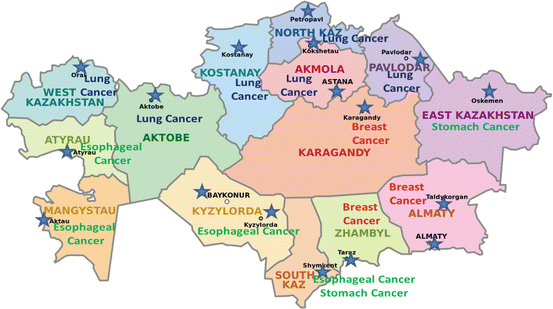

Fig. 18.3
Map of cancer morbidity by types and regions. Oncological map of Kazakhstan: Distribution of leading cancers in the various regions of Kazakhstan
History of the Oncology Service of Kazakhstan
History of the oncology service refers to the document “Improving cancer care to the population of Kazakhstan” 1945. Then, first oncology department for 25 beds was established in 1945. Afterwards, on this basis, Republican Oncology Center was organized in 1947. Later, the oncology care system continued its rapid development. So, in 1947–1949 14 regional oncology centers, 1 city oncology center, 2 oncology departments, and 22 oncology offices were launched. As a consequence of scientific needs, the Kazakh National Scientific Research Institute of Oncology was established in 1960.
Kazakhstan Cancer Care Service
Today, cancer care service comprises 1 National Research Institute, 19 regional centers, and 263 consulting rooms in local outpatient clinics. Hospital and outpatient treatment provide free professional care and medication.
Each year around 350–400 children under age of 15 fall ill with oncological disease. By the end of 2013, there were 1310 children registered with a diagnosis of malignant neoplasm.
Provision of medicines for cancer patients for the last 10 years increased by 17 times from 3.6 mln.euro (2002) to 61 mln.euro (2012). Amount of medical treatment has increased by more than 2.5 times.
Interrelationship Between Cancer Care and Local Culture
Different forms of cancer closely refer to national traditions. Some cases of widely spread cancer are assignable, some—remain a mystery. For instance, the age profile of Kazakhs (both male and female) is very similar to a world one and dominated by young people, while age structure of Russians is closer to Europeans with a predominance of older groups.
There are also demographical differences that have influence on national peculiarities, though most commonly overlooked. The surveys show that breast cancer of Slavic women pertains to endocrine factors. At the same time, breast cancer of Kazakh women (Altay group) progresses aggressively and ongoing studies have identified the absence of BRCA1 and BRCA2 genes. Perhaps, these newly discovered facts will cause shifts of views on the genetic nature of breast cancer.
In recent years, ecological factors have become primary in terms of the epidemiology of malignant tumors because oncogenic risk factors are closely related to the environment; it has been developed into a new direction—“ecological epidemiology of oncological diseases.” As stated earlier, Kazakhstan is second in the world by uranium resources. Main uranium fields are located in the North of the country, where an open and underground mining of uranium ore has been conducted intensively for more than 40 years. A big share of radioactive wastes has been accumulated to the present moment. Active and suspended wells and storing facilities—sources of radioactive contamination—pose a big danger to health of local population for those who work on a production and live nearby.
There are following noteworthy environmentally unsafe areas in Kazakhstan.
The Semipalatinsk Nuclear Test Site is located in East region. Here, for 40 years, since 1949 the vast majority of Soviet nuclear tests, including nuclear fusion and neutron bombs were conducted. Even though it has been more than 25 years since nuclear tests are over, its bad influence is still affecting not only the inhabitants of the Semipalatinsk region, but also the residents of neighboring regions. These north regions hold stable leading place in morbidity rank, with lung cancer prevalence.
It is still unknown how and to what extent people in regions close to Baikonur spaceport are affected. Here, we should note two factors that are harmful to their health and lead to cancer pathology development. First, heptyl that is used as a fuel in heavy liquid-propellant missiles contains many carcinogens, even in products of combustion. While not being fully burned out in disconnected rocket stages, it brings even greater damage to health and nature. Moreover, in case of a crash during the first phase of a rocket launching, liquid heptyl transforms into a droplet suspension, which then can cover significant territory inhabited with people and used for livestock and crop. Less attention is paid to the fact that every launched satellite leads to a hole in the ozone layer of our planet. This process, in its turn, reduces protective features of the atmosphere and increases the ultraviolet impact of the Sun that inevitably leads to an increase in skin cancer incidence on the territory of Kazakhstan around the spaceport.
Stay updated, free articles. Join our Telegram channel

Full access? Get Clinical Tree



